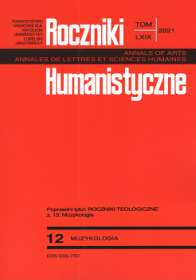A Microhistorical Reading of Ludwig Van Beethoven’s Piano Concerto No. 4
Abstract
This article is an attempt to indicate new areas in the study of Beethoven’s music (Fourth Piano Concerto), which can be developed by applying a microhistorical perspective to musicology. It begins with a short reflection on the usefulness and presence of microhistories in research on the art of sound. The author then presents the results of Mark Ferraguto’s analyses, focusing on such issues as Beethoven’s piano technique in relation to the expectations of his contemporary listeners; the category of virtuosity in the context of the aesthetic debates of the time; the composer’s artistic personality; and the possibilities and limitations of the instrument at his disposal in the process of composition.
References
Bourdieu, Pierre. „The Forms of Capital”. Handbook of Theory and Research for the Sociology of Education, red. John G. Richardson, Greenwood Press, 1986, ss. 241-258.
Cvejić, Žarko. The Virtuoso as Subject: The Reception of Instrumental Virtuosity, c. 1815–c. 1850. Cambridge Scholars Publishing, 2016.
Czerny, Carl. On the Proper Performance of all Beethoven’s Works for the Piano, red. Paul Badura-Skoda, Universal Edition, 1970.
Darnton, Robert. The Great Cat Massacre and Other Episodes in French Cultural History. Basic Books, 1984.
Davis, Natalie Zemon. The Return of Martin Guerre. Harvard University Press, 1983.
Epenhuysen, Maria Rose van. „Beethoven and His «French Piano»: Proof of Purchase”. Musique–Images–Instruments, nr 7, 2005, ss. 110-122.
Everist, Mark. Music Drama at the Paris Odéon, 1824–1828. U of California P, 2002.
Felski, Rita. „Context Stinks!”. New Literary History, t. 42, nr 4, 2011, ss. 573-591.
Ferraguto, Mark. Beethoven 1806. Oxford UP, 2019. AMS Studies in Music.
Forbes, Elliot. Thayer’s Life of Beethoven, t. 1. Princeton UP, 1964.
Ginzburg, Carlo. Il formaggio e i vermi. Il cosmo di un mugnaio del ‘500. Einaudi, 1976.
Hennion, Antoine. „Music and Mediation: Towards a new Sociology of Music”. The Cultural Study of Music: A Critical Introduction, red. Martin Clayton et al., Routledge, 2003, ss. 80-91.
Jander, Owen. „Beethoven’s «Orpheus in Hades»: The «Andante con moto» of the Fourth Piano Concerto”. 19th-Century Music, t. 8, nr 3, 1985, ss. 195-212.
Jones, David Wyn. Music in Vienna: 1700, 1800, 1900. The Boydell Press, 2016.
Kinderman, William. Beethoven. Oxford UP, 2009.
Knittel, K. M. „The Construction of Beethoven”. The Cambridge History of Nineteenth-Century Music, red. Jim Samson, Cambridge UP, 2001, ss. 118-510.
Latour, Bruno. Reassembling the Social: An Introduction to Actor-Network Theory (Oxford UP, 2005).
Le Roy Ladurie, Emmanuel. Montaillou, village occitan de 1294 à 1324. Éditions Gallimard, 1975.
Levi, Giovanni. Centro e periferia di uno Stato assoluto. Tre saggi su Piemonte e Liguria in età moderna. Rosenberg & Sellier, 1985.
Levitz, Tamara. Modernist Mysteries: Perséphone. Oxford UP, 2012.
Madrid, Alejandro L. „Why Music and Performance Studies? Why Now? An Introduction to the Special Issue”. Revista Transcultural de Música, nr 13, 2009.
McVeigh, Simon. „Concerto of the Individual”. The Cambridge History of Eighteenth-Century Music, red. Simon P. Keefe, Cambridge UP, 2009, ss. 583-612.
Metzner, Paul. Crescendo of the Virtuoso: Spectacle, Skill, and Self- Promotion in Paris during the Age of Revolution. U of California P, 1998.
Reimer, Erich. „Der Begriff des wahren Virtuosen in der Musikästhetik des späten 18. und frühen 19. Jahrhunderts”. Basler Jahrbuch für historische Musikpraxis: Eine Veröffentlichung der Schola Cantorum Basiliensis an der Musik-Akademie der Stadt Basel, nr 20, 1996, ss. 61-72.
Schmelz, Peter J. „«Shostakovich» Fights the Cold War: Reflections from Great to Small”. Journal of Musicological Research, t. 34, nr 2, 2015, ss. 91-140.
Senner, Wayne M., et al, redaktorzy. The Critical Reception of Beethoven’s Compositions by His German Contemporaries. U of Nebraska P, 2001.
Skowroneck, Tilman. „Beethoven’s Erard Piano: Its Influence on His Compositions and on Viennese Fortepiano Building”. Early Music, t. 30, nr 4, 2002, ss. 522-538.
Skowroneck, Tilman. Beethoven the Pianist. Cambridge UP, 2010.
Small, Christopher. Musicking: The Meanings of Performing and Listening. Wesleyan UP, 1998.
Oskar Sonneck, redaktor i tłumacz. Beethoven: Impressions by His Contemporaries. Dover, 1967.
Steinberg, Michael. The Concerto: A Listener’s Guide. Oxford UP, 2000.
Strunk, Oliver, redaktor. Source Readings in Music History. Norton, 1950.
Triest, Johann K. F. „Abhandlung: Über reisende Virtuosen”. Allgemeine musikalische Zeitung, t. 4, nr 46, 1802, szp. 737–749; nr 47, 1802, szp. 753–760; nr 48, 1802, szp. 769–775.
Copyright (c) 2021 Roczniki Humanistyczne

This work is licensed under a Creative Commons Attribution-NonCommercial-NoDerivatives 4.0 International License.





